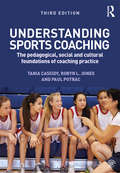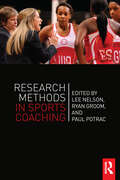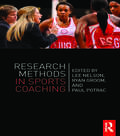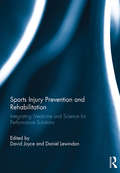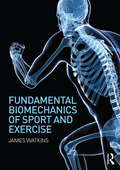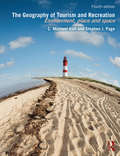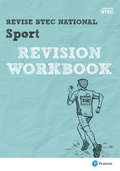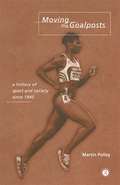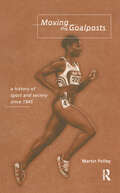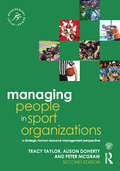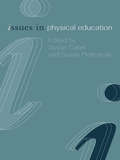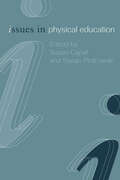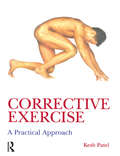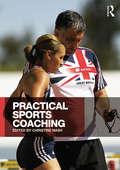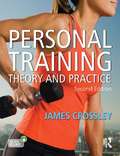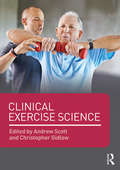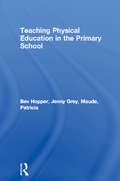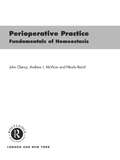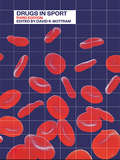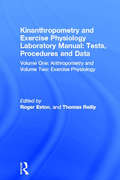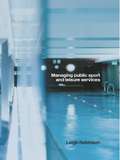- Table View
- List View
Understanding Sports Coaching: The Pedagogical, Social and Cultural Foundations of Coaching Practice
by Tania G. Cassidy Robyn L. Jones Paul A. PotracEvery successful sports coach knows that good teaching and social practices are just as important as expertise in sport skills and tactics. Now in a fully revised and updated third edition, Understanding Sports Coaching is still the only introduction to theory and practice in sports coaching to fully explore the social, cultural and pedagogical concepts underpinning good coaching practice. The book examines the complex interplay between coach, athlete, coaching programme and social context, and encourages coaches to develop an open and reflective approach to their own coaching practice. It covers every key aspect of coaching theory and practice, including important and emerging topics, such as: athletes’ identities athlete learning emotion in coaching coaching ethics professionalization talent identification and development coaching as a (micro)political activity Understanding Sports Coaching also includes a full range of practical exercises and extended case studies designed to encourage coaches to reflect critically upon their own coaching strategies, their interpersonal skills and upon important issues in contemporary sports coaching. This is an essential textbook for any degree-level course in sports coaching, and for any professional coach looking to develop their coaching expertise.
Research Methods in Sports Coaching
by Lee Nelson Ryan Groom Paul PotracResearch Methods in Sports Coaching is a key resource for any student, researcher or practitioner wishing to undertake research into sports coaching. It takes the reader through each phase of the research process, from identifying valuable research questions, to data collection and analyses, to the presentation and dissemination of research findings. It is the only book to focus on the particular challenges and techniques of sports coaching research, with each chapter including examples, cases and scenarios from the real world of sports coaching. The book introduces and explores important philosophical, theoretical and practical considerations in conducting coaching research, including contextual discussions about why it’s important to do sports coaching research, how to judge the quality of coaching research, and how sports coaching research might meet the needs of coaching practitioners. Written by a team of leading international scholars and researchers from the UK, US, Canada and Australia, and bridging the gap between theory and practice, this book is an essential course text for any research methods course taken as part of a degree programme in sports coaching or coach education.
Research Methods in Sports Coaching
by Lee Nelson Ryan Groom Paul PotracResearch Methods in Sports Coaching is a key resource for any student, researcher or practitioner wishing to undertake research into sports coaching. It takes the reader through each phase of the research process, from identifying valuable research questions, to data collection and analyses, to the presentation and dissemination of research findings. It is the only book to focus on the particular challenges and techniques of sports coaching research, with each chapter including examples, cases and scenarios from the real world of sports coaching. The book introduces and explores important philosophical, theoretical and practical considerations in conducting coaching research, including contextual discussions about why it’s important to do sports coaching research, how to judge the quality of coaching research, and how sports coaching research might meet the needs of coaching practitioners. Written by a team of leading international scholars and researchers from the UK, US, Canada and Australia, and bridging the gap between theory and practice, this book is an essential course text for any research methods course taken as part of a degree programme in sports coaching or coach education.
Sports Injury Prevention and Rehabilitation: Integrating Medicine and Science for Performance Solutions
by David Joyce Daniel LewindonWorld-class rehabilitation of the injured athlete integrates best practice in sports medicine and physical therapy with training and conditioning techniques based on cutting-edge sports science. In this ground-breaking new book, leading sports injury and rehabilitation professionals, strength and conditioning coaches, biomechanists and sport scientists show how this integrated model works across the spectrum of athlete care. In every chapter, there is a sharp focus on the return to performance, rather than just a return to play. The book introduces evidence-based best practice in all the core areas of sports injury risk management and rehabilitation, including: performance frameworks for medical and injury screening; the science of pain and the psychology of injury and rehabilitation; developing core stability and flexibility; performance retraining of muscle, tendon and bone injuries; recovery from training and rehabilitation; end-stage rehabilitation, testing and training for a return to performance. Every chapter offers a masterclass from a range of elite sport professionals, containing best practice protocols, procedures and specimen programmes designed for high performance. No other book examines rehabilitation in such detail from a high performance standpoint. Sports Injury Prevention and Rehabilitation is essential reading for any course in sports medicine and rehabilitation, strength and conditioning, sports science, and for any clinician, coach or high performance professional working to prevent or rehabilitate sports injuries.
Fundamental Biomechanics of Sport and Exercise
by James WatkinsFundamental Biomechanics of Sport and Exercise is an engaging and comprehensive introductory textbook that explains biomechanical concepts from first principles, showing clearly how the science relates to real sport and exercise situations. The book is divided into two parts. The first provides a clear and detailed introduction to the structure and function of the human musculoskeletal system and its structural adaptations, essential for a thorough understanding of human movement. The second part focuses on the biomechanics of movement, describing the forces that act on the human body and the effects of those forces on the movement of the body. Every chapter includes numerous applied examples from sport and exercise, helping the student to understand how mechanical concepts describe both simple and complex movements, from running and jumping to pole-vaulting or kicking a football. In addition, innovative worksheets for field and laboratory work are included that contain clear objectives, a description of method, data recording sheets, plus a set of exemplary data and worked analysis. Alongside these useful features are definitions of key terms plus review questions to aid student learning, with detailed solutions provided for all numerical questions. No other textbook offers such a clear, easy-to-understand introduction to the fundamentals of biomechanics. This is an essential textbook for any biomechanics course taken as part of degree programme in sport and exercise science, kinesiology, physical therapy, sports coaching or athletic training.
Fundamental Biomechanics of Sport and Exercise
by James WatkinsFundamental Biomechanics of Sport and Exercise is an engaging and comprehensive introductory textbook that explains biomechanical concepts from first principles, showing clearly how the science relates to real sport and exercise situations. The book is divided into two parts. The first provides a clear and detailed introduction to the structure and function of the human musculoskeletal system and its structural adaptations, essential for a thorough understanding of human movement. The second part focuses on the biomechanics of movement, describing the forces that act on the human body and the effects of those forces on the movement of the body. Every chapter includes numerous applied examples from sport and exercise, helping the student to understand how mechanical concepts describe both simple and complex movements, from running and jumping to pole-vaulting or kicking a football. In addition, innovative worksheets for field and laboratory work are included that contain clear objectives, a description of method, data recording sheets, plus a set of exemplary data and worked analysis. Alongside these useful features are definitions of key terms plus review questions to aid student learning, with detailed solutions provided for all numerical questions. No other textbook offers such a clear, easy-to-understand introduction to the fundamentals of biomechanics. This is an essential textbook for any biomechanics course taken as part of degree programme in sport and exercise science, kinesiology, physical therapy, sports coaching or athletic training.
The Geography of Tourism and Recreation: Environment, Place and Space
by C. Michael Hall Stephen J. PageThis fourth edition of The Geography of Tourism and Recreation provides students with a comprehensive introduction to the interrelationship between tourism, leisure and recreation from geographical and social science perspectives. It still remains the only book to systematically compare and contrast in a spatial context, tourism and recreation in relation to leisure time, offering insight into the demand, supply, planning, destination management and impacts of tourism and recreation.Whilst retaining its accessible style and approach this edition has been significantly updated to reflect recent developments and new concepts from geography which are beginning to permeate the tourism and recreational field. New features include: Content on the most recent developments, climate change, sustainability, mobilities and crisis management in time and space as well as trends such as low cost airlines and the control of land transport by transnational operators in the EU such as Arriva. More attention to management issues such as innovation and the spatial consequences for tourism and leisure development. New case studies and examples to showcase real life issues, from both developed and developing countries, especially the US, China and South Africa. Completely revised and redeveloped to accommodate new, user- friendly features: case studies, insights, summary points and learning objectives. Written by leading academics, this is essential reading for all tourism, geography, leisure and recreation students.
The Geography of Tourism and Recreation: Environment, Place and Space
by C. Michael Hall Stephen J. PageThis fourth edition of The Geography of Tourism and Recreation provides students with a comprehensive introduction to the interrelationship between tourism, leisure and recreation from geographical and social science perspectives. It still remains the only book to systematically compare and contrast in a spatial context, tourism and recreation in relation to leisure time, offering insight into the demand, supply, planning, destination management and impacts of tourism and recreation.Whilst retaining its accessible style and approach this edition has been significantly updated to reflect recent developments and new concepts from geography which are beginning to permeate the tourism and recreational field. New features include: Content on the most recent developments, climate change, sustainability, mobilities and crisis management in time and space as well as trends such as low cost airlines and the control of land transport by transnational operators in the EU such as Arriva. More attention to management issues such as innovation and the spatial consequences for tourism and leisure development. New case studies and examples to showcase real life issues, from both developed and developing countries, especially the US, China and South Africa. Completely revised and redeveloped to accommodate new, user- friendly features: case studies, insights, summary points and learning objectives. Written by leading academics, this is essential reading for all tourism, geography, leisure and recreation students.
Revise BTEC National Sport: Revision Workbook (PDF)
by Sue Hartigan Kelly SharpUpdates to BTEC National Set Tasks for external assessment - April 2017As a result of feedback from the Department for Education Pearson have made updates to the Set Tasks for some BTEC National qualifications. Therefore subsequent changes have been made to this product. If you have purchased this book before 13th April 2017, details of these changes can be found here. [link to www. pearsonfe. co. uk/BTECchanges]. Corrected copies will be available to purchase by June 2017. Exam Board: Pearson EdexcelAcademic Level: BTEC NationalSubject: SportFirst teaching: September 2016First Exams: Summer 2017 For all four of the externally assessed units 1 and 2. Builds confidence with scaffolded practice questions. Unguided questions that allow students to test their own knowledge and skills in advance of assessment. Clear unit-by-unit correspondence between this Workbook and the Revision Guide and ActiveBook.
Moving the Goalposts: A History of Sport and Society in Britain since 1945
by Martin PolleyMartin Polley provides a survey of sport in Britain since 1945 and examines sport's place in British culture. He discusses issues of class, gender, race, commerce and politics, as well as analysing contemporary sport.
Moving the Goalposts: A History of Sport and Society in Britain since 1945
by Martin PolleyMartin Polley provides a survey of sport in Britain since 1945 and examines sport's place in British culture. He discusses issues of class, gender, race, commerce and politics, as well as analysing contemporary sport.
Managing People in Sport Organizations: A Strategic Human Resource Management Perspective (Sport Management Series)
by Tracy Taylor Alison Doherty Peter McGrawManaging People in Sport Organizations provides a comprehensive overview of the theory and practice of managing people within a strategic framework. This revised and updated second edition examines a range of strategic human resource management approaches that can be used by sport organizations to respond to contemporary challenges and to develop a sustainable performance culture. Drawing on well-established conceptual frameworks and current empirical research, the book systematically covers every key area of HRM theory and practice, including: recruitment training and development performance management and appraisal motivation and reward organizational culture employee relations diversity managing change This new edition also includes expanded coverage of social media, volunteers, and individuals within organizations, and is supported with a new companion website carrying additional resources for students and instructors, including PowerPoint slides, exam questions and useful web links. No other book offers such an up-to-date introduction to core concepts and key professional skills in HRM in sport, and therefore?Managing People in Sport Organizations?is essential reading for any sport management student or any HR professional working in sport.
Issues in Physical Education
by Susan Capel Susan PiotrowskiIssues in Physical Education stimulates student-teachers, NQTs and practising physical education teachers to reflect on issues important to improving teaching in physical education. It encourages reflection and debate as an important part of professional development. Issues discussed include: aims as an issue in physical education breadth, balance and assessment in the physical education curriculum equality and the inclusion of pupils with special needs in physical education progression and continuity in physical education between primary and secondary schools community initiatives in physical education physical education, health and life-long participation in physical activity.
Issues in Physical Education
by Susan Capel Susan PiotrowskiIssues in Physical Education stimulates student-teachers, NQTs and practising physical education teachers to reflect on issues important to improving teaching in physical education. It encourages reflection and debate as an important part of professional development. Issues discussed include: aims as an issue in physical education breadth, balance and assessment in the physical education curriculum equality and the inclusion of pupils with special needs in physical education progression and continuity in physical education between primary and secondary schools community initiatives in physical education physical education, health and life-long participation in physical activity.
Corrective Exercise: A Practical Approach
by Kesh Patel Naomi WilkinsonCorrective and functional exercise is a rapidly advancing field. Exercise is an essential factor in all injury recovery, conditioning and performance, and if used correctly can play a preventative role in injury management. In the injured athlete, gym user or armchair athlete, corrective exercise can help to restore range of motion, re-build strength, endurance and power, re-establish neuromuscular control and balance, and provide positive progress for a specific sport or a healthier lifestyle.Written by an experienced specialist in the field of rehabilitative and performance exercise, this book provides an essential practical guide to corrective and functional exercise for every sports therapist and fitness trainer, particularly those taking diplomas or NVQs at level 3. Packed with photos and illustrations, and full of accessible step-by-step explanations of the latest rehabilitative methods, every corrective and functional technique is covered in detail, from initial consultation to whole body exercises.
Practical Sports Coaching
by Christine NashPractical Sports Coaching is a thorough and engaging guide for all sports coaching students and practitioners. Drawing on real-life case studies and examples, the book is designed to develop practical coaching skills and provides readers with the methods and tools they need to become an expert coach. Structured around all facets of the coaching process, the text comprehensively covers topics such as: preparation for coaching mentoring the philosophy of coaching direct intervention coaching methods the use of modern technology. The book’s practical approach allows the reader to consider common challenges faced by coaches, suggesting solutions to performance concerns and preparing students for the realities of professional sports coaching. A companion website containing presentation slides and useful weblinks makes the book a complete resource for students and lecturers alike. Practical Sports Coaching helps to bridge the gap between theory and practical coaching skills, and is an essential text for coaching students looking to deepen their understanding of sports coaching and experienced coaches developing their own practical skills.
Personal Training: Theory and Practice
by James CrossleyPersonal Training: Theory and Practice, Second Edition, draws together in one unique volume the personal, practical and business skills central to becoming a successful personal trainer. This accessible book introduces you to the fundamentals of applied exercise prescription and programme design, as well as advanced concepts including nutritional intervention, postural analysis and the psychology of behaviour change. Key Features- updated to reflect advances in training methodology and techniques in line with requirements for professional qualification- key points boxes, chapter summaries and a glossary of scientific and technical concepts to aid understanding- full colour illustrations and photos to support visual learning- case studies and sample exercise plans to help you put theory into practice- supported by online resources such as self-assessment tests, downloadable forms and session sheets at www.routledge.com/cw/crossley Personal Training: Theory and Practice is the ideal companion and handy reference for those embarking on a career in personal training as well as experienced trainers. Reviews of the first edition: 'the ideal companion to turn you from an amateur into a professional sports trainer...the only title tailored to meet the needs of UK-based personal training.' Work Out'a gem of a book...clearly written and presented which makes it easy for both fitness professionals and lay people to understand. Definitely worth buying.' Health and Fitness
Clinical Exercise Science
by Andrew Scott Christopher GidlowClinical Exercise Science is an introduction to core principles and best practice in exercise science for students and practitioners working with clinical populations. Combining the latest scientific research with evidence-based, practitioner-led analysis, the book offers integrated coverage of the full clinical exercise curriculum, including: Pathophysiology of exercise and disease Exercise as a clinical intervention Exercise, nutrition, and lifestyle Health behaviour change Clinical skills in exercise science The book covers a wide range of conditions, including cardiovascular disease, pulmonary disease, metabolic disease and mental health problems, and includes an array of useful features to guide student learning, such as case studies, study tasks, definitions of key terms and suggestions for further reading. With contributions from leading researchers and health practitioners, this is an invaluable foundation text for any clinical exercise science course, and useful reading for any student or practitioner working in exercise science, exercise rehabilitation, health science or physical therapy.
Teaching Physical Education in the Primary School
by Bev Hopper Jenny Grey Patricia MaudeThis book includes information on all six areas of the PE National Curriculum (games, gymnastic activities, dance, swimming, outdoor and adventurous activities, athletic activities), to increase subject knowledge and to develop teaching, management and planning skills.This book provides professional development for generalist primary teachers and student-teachers and also offers support to subject leaders charged with the responsibility for other colleagues. It will build on current practice and aim to increase knowledge, understanding, confidence and enthusiasm in an area of the curriculum which often receives a very short time allocation during initial teaching training courses.Teaching Physical Education in the Primary School is a comprehensive guide to the subject for primary educators. It deals with not only the teaching and learning of PE, but also everything that is relevant to co-ordinating the subject.
Teaching Physical Education in the Primary School
by Bev Hopper Jenny Grey Patricia MaudeThis book includes information on all six areas of the PE National Curriculum (games, gymnastic activities, dance, swimming, outdoor and adventurous activities, athletic activities), to increase subject knowledge and to develop teaching, management and planning skills.This book provides professional development for generalist primary teachers and student-teachers and also offers support to subject leaders charged with the responsibility for other colleagues. It will build on current practice and aim to increase knowledge, understanding, confidence and enthusiasm in an area of the curriculum which often receives a very short time allocation during initial teaching training courses.Teaching Physical Education in the Primary School is a comprehensive guide to the subject for primary educators. It deals with not only the teaching and learning of PE, but also everything that is relevant to co-ordinating the subject.
Perioperative Practice: Fundamentals of Homeostasis
by Nicola Baird John Clancy Andrew McVicarWritten by experienced nurse lecturers and a theatre nurse, Perioperative Practice highlights and explains the biological processes which can be disrupted by a major surgical procedure. Using the concept of homeostasis as a framework, the authors look at issues common to all surgical procedures such as the influence of anaesthesia on the nervous system or perioperative pain management. Individual chapters cover: the human body and principles of homeostasis the surgical approach and endoscopic procedures perioperative influences on body fluid homeostasis perioperative influences on immunological homeostasis and wound healing perioperative influences on cardiovascular homeostasis perioperative influences on respiratory homeostasis anaesthesia, stress and surgery pain and pain relief in the perioperative patient. Generously illustrated in colour and black and white, the text features further learning activities and useful summaries of key points. It provides an important resource and supporting text for all nurses undertaking courses in theatre work or related areas or already working in such areas.
Perioperative Practice: Fundamentals of Homeostasis
by Nicola Baird John Clancy Andrew McVicarWritten by experienced nurse lecturers and a theatre nurse, Perioperative Practice highlights and explains the biological processes which can be disrupted by a major surgical procedure. Using the concept of homeostasis as a framework, the authors look at issues common to all surgical procedures such as the influence of anaesthesia on the nervous system or perioperative pain management. Individual chapters cover: the human body and principles of homeostasis the surgical approach and endoscopic procedures perioperative influences on body fluid homeostasis perioperative influences on immunological homeostasis and wound healing perioperative influences on cardiovascular homeostasis perioperative influences on respiratory homeostasis anaesthesia, stress and surgery pain and pain relief in the perioperative patient. Generously illustrated in colour and black and white, the text features further learning activities and useful summaries of key points. It provides an important resource and supporting text for all nurses undertaking courses in theatre work or related areas or already working in such areas.
Drugs in Sport
by David MottramDrug use and abuse represents perhaps the most profound and high-profile issue facing sport today. Each major international championship seems to deliver a new drug-related controversy, while drug takers and sports administrators attempt to out-manoeuvre each other with new substances and new testing procedures.Drugs in Sport - 3rd Editionis a fully revised and updated version of the most comprehensive and authoritative text available on the subject. Leading figures in the field explore the hard science behind every major class of drug, as well as the social, ethical and organisational dimensions to the issue.Key topics include:* analysis of all the key substances, including anabolic steroids, EPO and human growth hormone* alcohol and social drug use in sport* creatine and nutritional supplements* evidence and issues around doping control in sport.This is a highly accessible text for all sports science and sports studies students, coaches and professional sports people, and sports administrators and policy-makers.
Kinanthropometry and Exercise Physiology Laboratory Manual: Exercise Physiology
by Thomas Reilly Roger EstonThis is a combined set of the two fully revised and updated manuals Kinanthropometry and Exercise Physiology Laboratory Manual: Tests, Procedures and Data. The in-depth analyses of anthropometry and exercise physiology are presented in one volume for the first time. Physiology and practical work is now a compulsory element of sports and exercise science. These texts have been developed as key resources for lecturers and students of kinanthropometry, sports science, human movement and exercise physiology. The well-illustrated manuals provide: * help in planning and conduct of practical sessions* comprehensive theoretical background on each topic and up-to-date information so that there is no need for additional reading* seven entirely new chapters providing a balance between kinanthropometry and physiology* eleven stand-alone chapters in each volume enabling the reader to pick out topics of interest in any order* a wide range of supporting diagrams, photographs and tables. A complete one-stop resource, this set presents laboratory procedures next to real-life practical examples, each supported with appropriate data. In addition, each chapter is supplemented by a complete review of contemporary literature, as well as theoretical overviews, offering an excellent basic introduction to each topic.
Managing Public Sport and Leisure Services
by Leigh RobinsonThe public sector is the largest provider of sport and leisure facilities and the biggest employer of leisure management graduates – the last decade has seen enormous changes in this sector. In this significant new student textbook – the first to investigate leisure management in a public sector context – Leigh Robinson examines the unique issues facing public sector managers and analyzes the application of contemporary management strategies and techniques to public sector leisure. It provides thorough coverage of the work and skills required in addition to the challenges and issues facing leisure managers. This book also challenges the perceptions and negative comparisons with the private sector. Written using a clear and user-friendly style, this textbook will be core reading for students of sport, leisure and recreation management, and makes an accessible reference for practicing managers working across the spectrum of leisure provision, from sport facilities through to parks, arts and heritage.
